Explore Montalcino's Medieval Charm and Savor Brunello Wine. Discover Italy's Treasured Village on Your Tuscan Journey.
Read more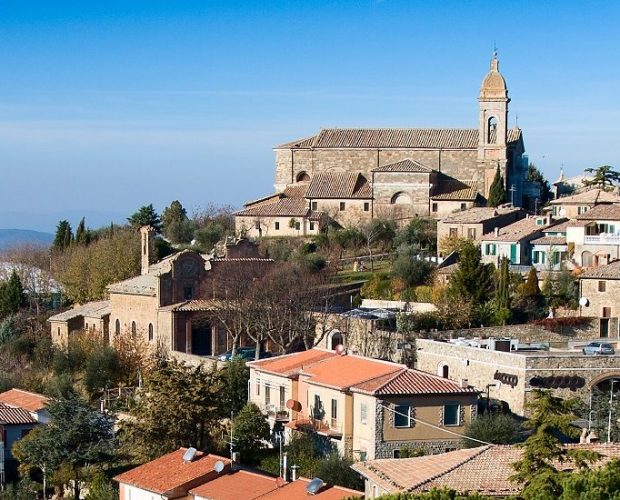
EXPLORE ALL OUR TUSCANY WINE REGION GUIDES
Last updated: May 6, 2024
The genesis of the Super Tuscan took place on an unremarkable patch of scrubland adjacent to some abandoned strawberry fields in a place called the Maremma Toscana. Here, the Marchese Incisa della Rochetta decided to plant Cabernet Sauvignon and Merlot in the 1940s, determined to prove that Tuscan reds could rival the finest wines of Bordeaux. He succeeded: the first vintages of Sassicia revealed flavors not seen in Italy before. Thanks to the proselytizing of his nephews Piero and Lodovico Antinori, Sassicia has become one of Europe’s most sought-after wines; new estates have proliferated as investors seek their fortune in this untamed landscape.
Yet the magic of the Tuscan Coast has not been diluted. Indeed, the Maremma has retained an exclusive air: few cellars are open to the general public, and even the most beautiful spots never feel overcrowded. Meanwhile, towns like Castiglione Della Pescaia (charming fishing port and castle), Pitigliano, and Massa Maritima (with its quaint cobblestoned, medieval streets) are all undiscovered little gems. They form part of what might today be called Tuscany’s gold coast – where ancient terroir meets New World freedom.
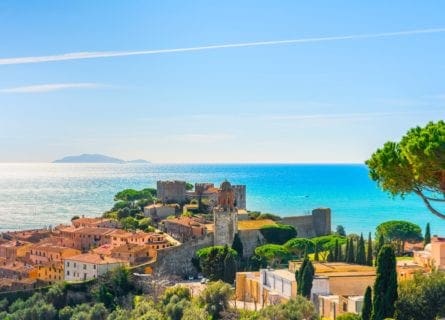
In the 9th century BC, the Etruscans colonized the fertile landscape of central Italy. This sophisticated culture planted vines in the hills of Chianti and Montalcino; however, the Maremma was deemed unsuitable for viticulture due to its boggy, mosquito-infested terrain. Nevertheless, the area was known as the “breadbasket of Etruria” in the Roman era, as certain forms of agriculture did flourish along the Tyrrhenian coastline. In 88 BC, the Romans established the province of Tuscia, granting the Etruscans citizenship and complete autonomy over their affairs. Peace and prosperity reigned for over four hundred years.
However, Rome’s authority weakened to the point of total collapse in the 5th century, while the Visigoths, Vandals, and Ostrogoths poured into western Europe from Germania and the Balkans. After many fierce battles, the Lombards managed to subjugate most of the Italian Peninsula, transforming the duchy of Spoleto into a booming trade empire. Yet, in 774, the Frankish king Charlemagne ejected the Lombards from Italy after agreeing to an alliance with the Catholic Church in Rome. His control over Tuscany was confirmed by Pope Hadrian I – Maremma’s capital, Grosseto, became part of the vast Holy Roman Empire. The city of Siena subsequently controlled it until the Holy Roman Emperor Charles V appointed Cosimo I de Medici the first grand duke of Tuscany.
Many centuries later, his successor, Leopoldo II, initiated an ambitious project to drain the province’s marshland; Flemish engineers carried out a similar undertaking in the Medoc in the 1600s. In 1829, thousands of laborers traveled to the Maremma to work alongside Giuseppe Mazzanti, an experienced farmer working on this land for decades. Mazzanti decided to close the defunct Seggio Vechio canal and build a new one, Seggio Nuovo, in its place. Thus, swampland was transformed into dry terrain that could be planted to vines. Yet it was not until the mid-20th century that pioneers like the Marchese Incisa della Rochetta began to make wine here. He inspired other visionaries such as Lodovico Antinori and Elisabetta Geppetti; the latter planted the Saffredi vineyard in 1985. We could add Ornellaia (now owned by the Frescobaldis), Angelo Gaja’s Ca’ Marcanda, and Guado al Tasso. They are all legends in their own right.
The Maremma is one of Europe’s great undiscovered treasures. Running parallel to the Tyrrhenian Sea, the region begins just south of the port of Livorno, continuing down to Grosseto in southwestern Tuscany. It is traditionally divided into two subregions: Alta Maremma and Maremma Grossetana. The former includes the region’s most famous appellation, Bolgheri, home to collector favorites Sassicaia and Masseto. One of the region’s leading terroirs is the aptly named Colline Metallifere, a chain of hills rich in minerals that forms an amphitheater with a very advantageous climate: mild winters and a long, dry growing season between May and October. There are over 2,480 sunshine hours per year in the Maremma. Rain-soaked vintages are very rare in this Mediterranean vineyard.
Yet the terrain and soils of the Maremma are far from homogeneous. In the midst of herb-covered scrubland, hills, and pine forests, you’ll find igneous and calcareous terroir; loam, sandstone, gravel, clay, and sandy soils enable a wide range of styles to be made here. This has been a major priority over the past 15 years: matching the correct variety to the right site. The best plots for Cabernet Sauvignon have turned out to be the higher, stonier plantings. However, Merlot needs soils with a high clay content. Elsewhere, warm sandy soils yield light and aromatic reds of great finesse; Petit Verdot tends to do well in the warmest climats (vineyard sites) of the Maremma.
However, a growing volume of white wine is produced in southwestern Tuscany – white grapes require cooler spots and water-retentive terroir. Fortunately, this part of Tuscany offers an infinitely variable topography, with important elevation, mesoclimate, and aspect differences. Some of the zone’s finest Chardonnay and Sauvignon Blanc, for example, are planted on north-facing sites close to the Tyrrhenian Sea; maritime breezes help to cool the vine canopy and preserve freshness in the wines. Meanwhile, high-altitude vineyards enjoy all the benefits of diurnal temperature variation – a significant temperature difference between day and night. This helps to slow the vine’s metabolism and prevent acid levels from falling below desirable levels. Nevertheless, irrigation may be necessary in the Maremma’s increasingly torrid summers to avoid hydric stress and vine shutdown.
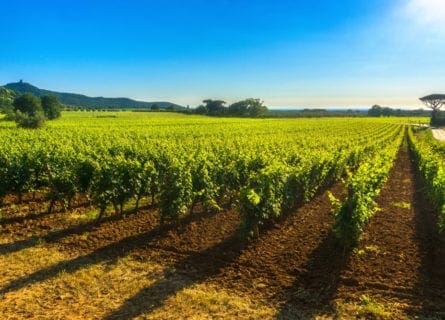
The Maremma is often referred to as the “Wild West,” both in terms of its landscapes and winemaking. Indeed, both the Maremma DOC (founded in 2011) and the IGT (Indicazione Geografica Tipica) designations permit a broad spectrum of wine styles to be made here, including Bordeaux blends, sumptuous Chardonnay and crisp Vermentino. A philosophy that is best described as ‘New World’ has taken root here; it is common practice (and encouraged by the authorities) to reference grape varieties on the front label. By comparison, this would be severely frowned upon when marketing Brunello di Montalcino or Chianti Classico. Moreover, the Consorzio updated the rules in 2020 to allow two varieties to be named on the bottle. This ruffled feathers in the more reactionary enclaves of Tuscany, yet it has proven to be a massive hit with consumers.
But the region’s biggest commercial success remains the Bolgheri Rosso DOC – Sassicaia has its own appellation. Bolgheri Rosso can be built around 100% Cabernet Sauvignon, Merlot, or Cabernet Franc, although many winemakers prefer to emulate the Bordeaux philosophy of blending two or more varieties to enhance complexity; Syrah and Sangiovese can constitute up to 50 percent of the blend, while Petit Verdot is limited to 30 percent. As elsewhere, fermentation methods can vary significantly from property to property, although all the best Bolgheri reds are matured in oak, normally French barrique. With careful winemaking and judicious barrel aging, Bolgheri Cabernet Sauvignon will reveal intense blackcurrant flavors, blueberry, vanilla, and tobacco. Of course, Alta Maremma is not the only source of delectable Cab.
Further south, Giacomo Tachis aided Elisabetta Geppetti in establishing Fattoria Le Pupille on the outskirts of Grosseto. Planted on sandstone terroir, Geppetti’s Cabernet is glorious in its exoticism: mature vintages reek of truffles, prunes, and sweet spices. The Sangiovese reds of Morellino di Scansano DOCG are no less fine.
Meanwhile, Bolgheri Bianco stakes its reputation on fresh and fruity Vermentino, blended with smaller amounts of Sauvignon Blanc and Trebbiano Toscano. Rosé and sparkling wine styles are growing in popularity, too – a competitor to Prosecco, perhaps? Ambitious producers are also increasingly focused on marketing a superior Riserva category of wine, regulated by the Maremma DOC framework. Thus, white wines must be aged for a period of one year before release; Rosso Riservas spend two years (six months in wood) in quiet contemplation before they can be sold.
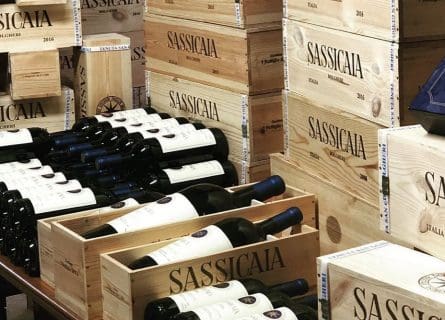
The Maremma produces such a profusion of wine styles, made on diverse mesoclimates and soils using ever-changing methods, that attempts to parcel them neatly are foolish and impossible. Yet the region does have a signature grape variety, and that variety is Cabernet Sauvignon. Yes, indeed – Sangiovese does not pay the piper in the vineyards of coastal Tuscany. It is one of the few wine zones where imported grapes routinely outperform their Italian neighbors.
This has been the case since Sassicaia exploded onto the scene in 1971 (first vintage 1968), wowing the critics and silencing the naysayers. Although Tignanello, Solaia, and their modern contemporaries are exceptional wines, there is no doubt that Bolgheri-grown Cabernet Sauvignon surpasses all competition from central Tuscany. Of course, not everyone welcomes this reality: the continued planting of French grapes at the expense of indigenous varieties can upset the traditionalists. Some have even called this “an invasion” as Chardonnay, Merlot, and Cabernet become ubiquitous worldwide.
But the fact remains that Maremma Cabernet Sauvignon is outstanding: far more than simply another varietal expression of the grape. Thus, the best wines offer a synergy of terroir, climate, and winemaking. They marry the best elements of Bordeaux and Tuscany – the scent of garrigue interspersed with cassis. The top examples are very fragrant and supple; where Merlot has been added, they are voluptuous and round. Moreover, while they improve with bottle age, they do not require a decade in the cellar: three to four years will see most reds become approachable, including Ornellaia. As the estate’s ex-winemaker Axel Heinz once observed, “Ornellaia is more immediate, opulent and extrovert than say a typical Medoc, but with the freshness and balance essential for any fine wine to age.” In the world of deluxe Cabernet, Tuscany has few peers.
Chardonnay is a green-skinned grape varietal native to the Burgundy wine region in France and one of the most popular varieties worldwide.
Find out moreExplore Gros Manseng, a captivating white wine grape flourishing in South West France's Jurançon region. Unveil its delightful flavors!
Find out morePetit Manseng is a white grape grown mainly in the South West of France that produces high-quality sweet wines. It's one of France's best-kept wine secrets.
Find out moreDiscover Pinot Grigio's Transformation: From Ordinary to Exceptional in Italian White Wine. Explore the Revolution!
Find out moreThe sauvignon blanc grape varietal, originally from the Bordeaux region of France, is now one of the world's most loved white varieties.
Find out moreExplore the Renaissance of Sardinian Vermentino: From Forgotten Grape to Crisp Elegance. Discover Now!
Find out moreAlicant Bouschet is a red wine grape popular in the Alentejo located in Southern Portugal. It's a cross of Petite Bouschet and Grenache grapes.
Find out moreCabernet Franc grape is a close relative of Merlot and Cabernet Sauvignon and is the principal blending grape used in Bordeaux.
Find out moreDiscover the irresistible allure of Cabernet Sauvignon—a worldwide favorite with robust, dark-bodied flavor. Unleash your wine journey today!
Find out moreMerlot is the most cultivated grape in Bordeaux and closely related to Cabernet Franc
Find out morePetit Verdot is a full-bodied red wine grape varietal used in classic Bordeaux blends and originates in southwestern France
Find out morePinot noir is a light-bodied red wine varietal closely related to the Vitis vinifera grape and produces the most sought-after red wines in the world.
Find out moreUnearthing Sangiovese: Italy's Ancient Grape with a Complex History. Explore its journey from Etruscans to modern-day excellence.
Find out moreSyrah is dark-skinned and perhaps the most underrated of the 'noble' red grape varieties.
Find out moreFarm-to-table dining is a way of life in the bucolic landscape of southern Tuscany. But your options aren’t limited to the interior: sensational seafood is always up for grabs in the Maremma, particularly in the underrated city of Livorno. Try the cacciucco, a pungent fish stew of octopus, and whatever else was swimming about that morning! All those concentrated Bordeaux blends in Bolgheri demand an equally robust pairing: cinghiale (wild boar) shoulder is divine, slowly cooked in Merlot and served with garlic mash.
A Guide to the Gastronomy and Cuisine of Tuscany: Read more

Explore Montalcino's Medieval Charm and Savor Brunello Wine. Discover Italy's Treasured Village on Your Tuscan Journey.
Read more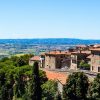
Visit Cortona, Tuscany's hilltop gem with Etruscan roots, Renaissance art, and stunning Val di Chiana views, as seen in 'Under the Tuscan Sun'.
Read more
Explore Florence: A Renaissance marvel with stunning art, architecture, and a rich winemaking legacy, in the heart of Tuscany.
Read more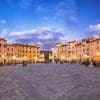
Explore Lucca, a tranquil Tuscan town with 16th-century walls, charming lanes, rich musical history, and picturesque biking trails.
Read more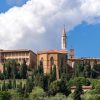
Discover Pienza's Renaissance Charm and Rich History in the Heart of Tuscany's Val d'Orcia. Explore Etruscan Roots, Renaissance Architecture, and Timeless Beauty.
Read more
Discover Pisa's Rich History and La Dolce Vita - Beyond the Leaning Tower. Explore a Cultural Gem in Northern Tuscany.
Read more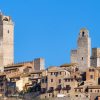
Explore San Gimignano, Tuscany's 'medieval Manhattan', with historic towers, charming streets, fine wines, and a rich, romantic history.
Read more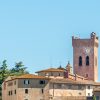
Discover San Miniato, the Tuscan gem: medieval allure, renowned truffle festival, diverse cultural theater, and panoramic valley views.
Read more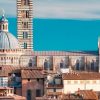
Discover Siena, a Tuscan gem with rich history, stunning medieval architecture, cultural wonders, and proximity to Italy's famous wine regions.
Read more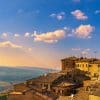
Volterra, 'Little Rome': A Tuscan gem where Etruscan artistry, medieval charm, and Renaissance beauty blend in a picturesque setting.
Read moreIf you would like us to customize an exclusive luxury tour, contact us and let us know your travel plans. We offer luxury food and wine tours for private groups of a minimum two guests. In addition, all of our private, chauffeured tours are available year-round upon request.

